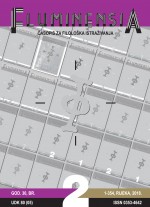PRAGMASTYLISTICS OF THE LYRIC POEM (Ivan Slamnig: Kad mi svega bude dosta)
Keywords:
pragmatics, stylistics, deixis, speech acts, lyric poem, Ivan SlamnigAbstract
The paper sketches out the potential overlap of stylistics and pragmatics in order to come up with a new hermeneutic model for the interpretation of a lyrical text. The introduction lays down the basic information on pragmatics as a discipline, its founders (H. P. Grice and J. L. Austin) and its main concepts (deixis and speech acts) from which a general hypothesis of the performativity of literary discourse (Sh. Felman) is derived as well as the performative hypothesis (S. Levin) upon which literary communication is built. The central part of the paper offers the pragmastylistic reading of Ivan Slamnig’s poem Kad mi svega bude dosta. The poem is first put in the context of Slamnig’s poetry and then subjected to the stylistic analysis of its main features: the apparent ”lightness” and communicativeness, the influence of the ”colloquial” style, a neat and symmetrical composition, metrical procedures (trochaic tetrameter, internal rhyme, isosyllabic verse). The main hypothesis upon which interpretation is built is that the poem, which at the first glance appears easily accessible and comprehensible, when approached from the pragmastylistic perspective, seems quite different: its ”lightness” is unmasked as an illusion due to the fact that the lyrical subject makes specific linguistic and stylistic choices (commissive speech acts and deixis) in order to obstruct lyrical communication. The interpretation thus primarily focuses on the self-reflexivity and performativity of Slamnig’s poetic discourse to distinguish itself from traditional constative interpretations which dwell on deciphering the poem’s textual meanings.

